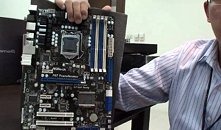Friday, November 26th 2010

ASRock Designs LGA1156 Motherboard Based on Intel P67 Chipset
ASRock is known to mix and match sockets and chipsets to come up with some interesting hybrids that give users access to latest features offered by the chipset. A recent example of this is a socket 939 motherboard based on the AMD 785G chipset (read here), which gives users of socket-939 Athlons access to a fast IGP and PCI-Express 2.0. The company's latest such innovation is the P67 Transformer. This is a socket LGA1156 motherboard, it supports existing Core i5/Core i7 "Lynnfield", and Core i3/Core i5 "Clarkdale" processors, but is based on the Intel P67 Express chipset. The board gives users access to some advanced features of the P67 chipset, but won't support LGA1155 processors.
So what's in it for you? Well, the P67 PCH embeds a PCI-Express 2.0 hub compared to P55/H55, which pack an older PCI-Express 1.1 hub. The older hub is known to heavily bottleneck devices such as USB 3.0 and SATA 6 Gb/s controllers that use only a single PCI-E lane (since PCI-E 1.1 has 250 MB/s per direction bandwidth, compared to 500 MB/s on the PCI-E 2.0). So significant is this bottleneck, that some motherboard designers even used bridge chips that convert the P55's PCI-E 1.1 x4 port to two PCI-E 2.0 x1, for USB 3.0 and SATA 6 Gb/s controllers. The PCI-E x16 slots however, are wired to the processor and are Gen 2. ASRock's board hence gives you two USB 3.0 and two SATA 6 Gb/s with an alleviated bus bottleneck.The P67 Transformer is a standard ATX board with an LGA1156 socket, four DIMMs for dual-channel DDR3, one PCI-Express 2.0 x16 slot for graphics, three PCI-E x1, and two PCI. Storage connectivity includes two SATA 6 Gb/s, four internal SATA 3 Gb/s, eSATA. There are two USB 3.0 ports, a number of USB 2.0 ports, gigabit Ethernet, and 8 channel HD audio. ASRock claims that this board is capable of extremely high memory overclocking capabilities. It masked the rated DDR3 frequency capability on the motherboard, and is challenging you to guess it on its Facebook page. A lucky winners gets one of these boards. The P67 Transformer will be out in early December. A YouTube video related to the board can be watched here.
Source:
TweakTown
So what's in it for you? Well, the P67 PCH embeds a PCI-Express 2.0 hub compared to P55/H55, which pack an older PCI-Express 1.1 hub. The older hub is known to heavily bottleneck devices such as USB 3.0 and SATA 6 Gb/s controllers that use only a single PCI-E lane (since PCI-E 1.1 has 250 MB/s per direction bandwidth, compared to 500 MB/s on the PCI-E 2.0). So significant is this bottleneck, that some motherboard designers even used bridge chips that convert the P55's PCI-E 1.1 x4 port to two PCI-E 2.0 x1, for USB 3.0 and SATA 6 Gb/s controllers. The PCI-E x16 slots however, are wired to the processor and are Gen 2. ASRock's board hence gives you two USB 3.0 and two SATA 6 Gb/s with an alleviated bus bottleneck.The P67 Transformer is a standard ATX board with an LGA1156 socket, four DIMMs for dual-channel DDR3, one PCI-Express 2.0 x16 slot for graphics, three PCI-E x1, and two PCI. Storage connectivity includes two SATA 6 Gb/s, four internal SATA 3 Gb/s, eSATA. There are two USB 3.0 ports, a number of USB 2.0 ports, gigabit Ethernet, and 8 channel HD audio. ASRock claims that this board is capable of extremely high memory overclocking capabilities. It masked the rated DDR3 frequency capability on the motherboard, and is challenging you to guess it on its Facebook page. A lucky winners gets one of these boards. The P67 Transformer will be out in early December. A YouTube video related to the board can be watched here.

38 Comments on ASRock Designs LGA1156 Motherboard Based on Intel P67 Chipset
intel > hmm... not sure
asrock > SLAAAP !!!
if motherboard company's can make things backward compatible like this why cant intel do the same
I don't think this board will see light of day, intel will go nuts :laugh:
But anyway, back to ASRock:
Their innovation always amazes me, and their quality and OCing has been increasing at a steady clip as well. I might have an ASRock board sometime in my future.
As for AsRock I always thought that they were spin off from ASUS, in a sense they're turning out to be more innovative than ASUS.
To me, 'static killed it' is a way of saying 'i have no idea whats wrong, but i want you to pay me for my time anyway'
I've never had a fatality when not using my anti-static strap or the a-like, it just annoys me that's all. I'm (too) pedantic if you like. Just because it hasn't happened to you doesn't mean it won't happen, hence why these guide lines are in place.
the closest it gets is the bags say "ESD sensitive device" and thats about it. the really paranoid buy the wrist straps, the rest of us just dont care.
You don't need guidelines Mussels, just a lil electrical understanding.
Put the wrong voltage/amperage through an electrical device and it can fail.
Static shocks can sometimes have pretty epic charges behind them. ( see lightning for most epic example, enough power to instantly burst things into flames or even explode them if evaporation happens fast enough)
Check out this voltage to spark length data
mm gap
0.5
1
2
3
4
5
volts
2850
4350
7350
10350
13350
16350
Also check this out, whilst it's about static generated with car-seats n shit should be eye opening about just how much voltage can be built up just with fabric lol
www.jci.co.uk/Carseats2.html#5